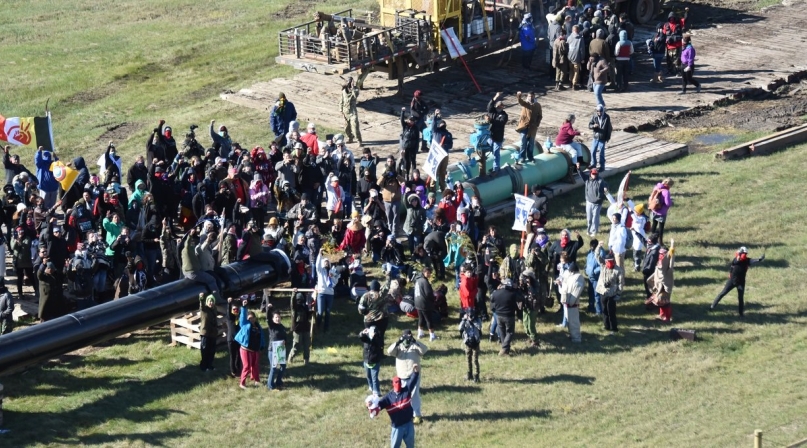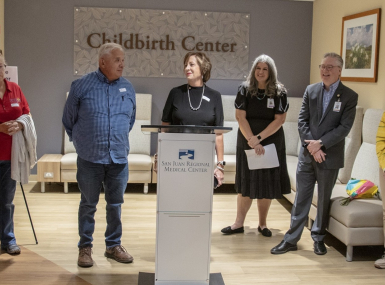Lessons Learned from Pipeline Protest
Upcoming Events
Related News

On Aug. 9, 2016, if I would have told the residents of Morton County and the greater Mandan-Bismarck area of North Dakota that their lives and the community were about to change forever, I don’t think many people would have believed me. But that is exactly what happened as a result of nearly eight months of historic, many times violent, protests surrounding the Dakota Access Pipeline (DAPL).
The DAPL Protest brought thousands of people from around the country to stand in solidarity with Standing Rock, a tribal community with important cultural and territorial distinctions. But what began as a peaceful protest, touching on important environmental, legal and cultural issues, would soon become a violent movement, fueled by multi-million-dollar crowdfunding sites and propaganda.
Fear crept into farmsteads, local businesses, schools and the homes of law enforcement families. But fear also permeated the camps, as agitators pushed their agendas and many became victims of abuse and neglect.
How can counties prepare?
As I reflect on the past year and a half and Morton County’s response to the protest, I urge other counties across the country that could find themselves in a similar situation to prepare now, using the lessons we learned amid the longest running protest in modern American history.
First, don’t underestimate the potential of a protest event. Don’t expect activity to be organized and non-violent. In other words, prepare for the worst and hope for the best. Have in place the manpower or mutual aid agreements, including logistics and communication, to respond immediately to any rapid escalation. At the start of the DAPL protest, law enforcement and county leaders never expected the activity to shift so quickly — and to remain for so long.
Some key considerations for elected leaders, emergency management officials and law enforcement:
- The three most important things in emergency management and crisis response are: communication, communication and communication. This includes communicating with leaders of adjoining jurisdictions, internal and external stakeholders and the media. Formalize your communication structure and demand accountability. A breakdown in communication can become very detrimental to operations and morale. Be explicit and precise in how a message moves through the chain of command. This proved challenging for us since we had staff scattered across three physical locations 40 miles apart.
- Set up a Unified Command as soon as possible. Depending on state laws, legal responsibilities may differ but a unified command allows for “one message, one voice” as you move through an incident.
- Gather your Public Information Officers. Based on the agencies involved, bring these people together early. You may need to engage member organizations to assist such as the state-national association of counties, sheriff’s association or emergency management association. These groups proved invaluable to us.
- Develop your social media accounts with appropriate guidelines now. Become comfortable with social media and build your support base so when you need it to share your message, you are well-positioned.
- Invest in audio-video assets. The money spent here will be well worth it. In order to combat the misinformation that can go viral on social media, obtain your own video to tell the whole story. Also, the mere presence of cameras can de-escalate a situation since people don’t want to be captured on camera performing illegal activity.
- Formalize training and orientation. When mutual aid arrives, there is a lot of event-specific knowledge that is critical to the operation. Create a written or video orientation and take time to discuss the reporting requirements for each person new to the scene.
- Don’t get caught in the “emergency of the day.” Look beyond the response and consider reports, evidence processing, intelligence updates and databases. We didn’t have the manpower dedicated to processing and data-basing incoming video, and it hindered our information efforts. Invest in customizable software applications to help.
- Track your resources as they arrive. With the multitude of mutual aid personnel, it is essential to account for all personnel and their time, equipment, etc.
- Know your technology. A communication plan needs to be in place for radios, phones and encryption concerns — especially as personnel from other agencies come to assist.
Without question, the priority of everyone involved in the DAPL protest response was maintaining public safety and protecting the constitutional rights of everyone involved. The numerous men and women who served Morton County did so with great restraint and the utmost professionalism.
Seeking peaceful, respectful dialogue
Perhaps the greatest lesson learned from 234 days of protest response is breaking down the barrier of fear — bridging the gap through open communication and a willingness to understand each other.
This was an important reason I chose to accept an invitation to the Nobel Peace Prize Forum in Oslo, Norway in December 2017 titled “Across Dividing Lines” focusing on indigenous peoples’ rights in the context of social justice and environmental protection. The subject matter is very important, and our recent experience was particularly relevant to the broader conversation.
I was able to share my experiences with forum sponsors, staff from the Nobel Institute of Norway, the president of the Sami (Indigenous Peoples of northern Norway) Parliament, and the Secretary General of the Norwegian Mineral Industry with the hope that my experience could help others.
My goal was twofold — to learn and to teach. I wanted to make sure that all of the facts of the DAPL protest were properly understood and the perspective of local landowners, law enforcement and emergency responders were represented, because I believe the media, especially at the national and international level, did a very poor job reporting that side of the story. Just as Standing Rock felt they weren’t being heard during the pipeline approval process, our residents felt their rights were trampled upon by mostly out-of-state protesters claiming to represent Standing Rock.
The purpose of the forum was to move the focus from single-issue solution efforts that may only consider effects, to well-designed, coordinated, multi-sector solutions that focus on all levels of the problem: values, causes, and effects. The first step to agreement is understanding, and the forum provided an excellent platform to move toward that goal.
Where do we go from here?
As we move forward, Morton County will be eternally grateful to law enforcement and emergency management professionals that came to our aid — from counties and cities across the country. We proudly stand side-by-side with those who agree that open and honest communication is key to resolving differences between neighbors and returning to a peaceful environment.
We absolutely believe that we must use this as an opportunity to build even stronger relationships both individual to individual and government to government. This will take time and effort, but it is an investment that we are eager to make.
Attachments
Related News

Now I know I can adapt my communication style
San Juan County, N.M. Commissioner Terri Fortner spent her career working with people one-on-one, but she overcame hangups about online communication when the pandemic forced her onto video calls when she first took office.

County service meets a veteran’s need for purpose in Spotsylvania County, Virginia
After Drew Mullins transitioned from a high-performance lifestyle in the military, he found the environment and purpose he sought when he took office in his county.
Now I know that solid waste is complicated
Custer County, Idaho Commissioner Will Naillon says solid waste removal is "one of the things that people often take for granted until it’s their job to make sure it happens... that’s the story of being a county commissioner."